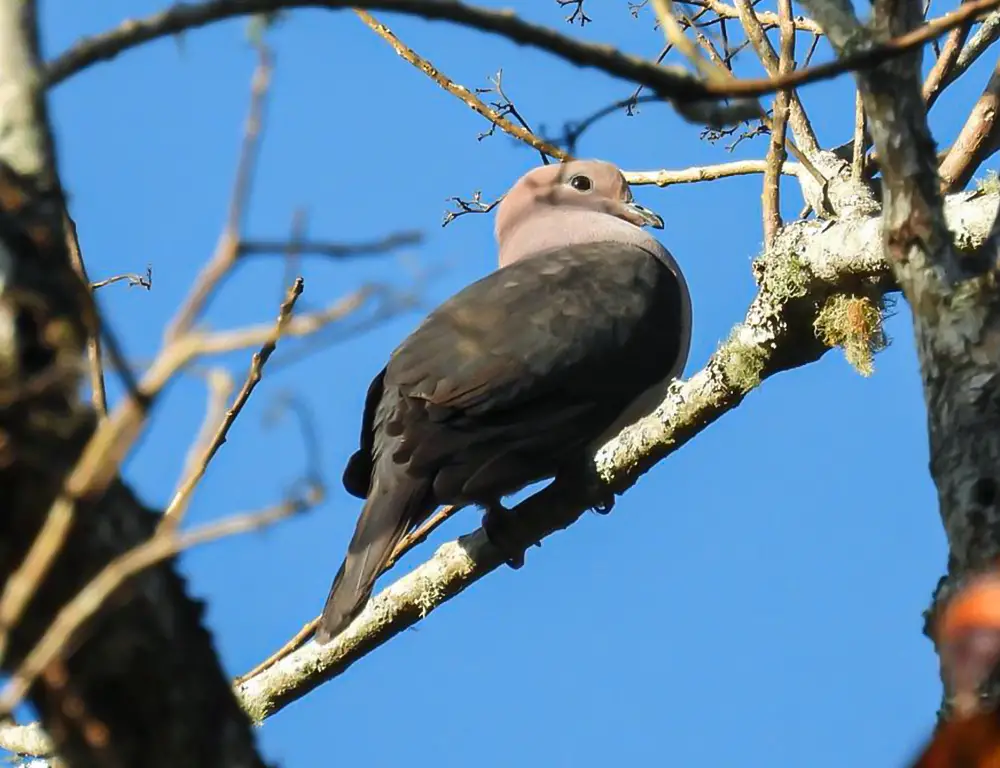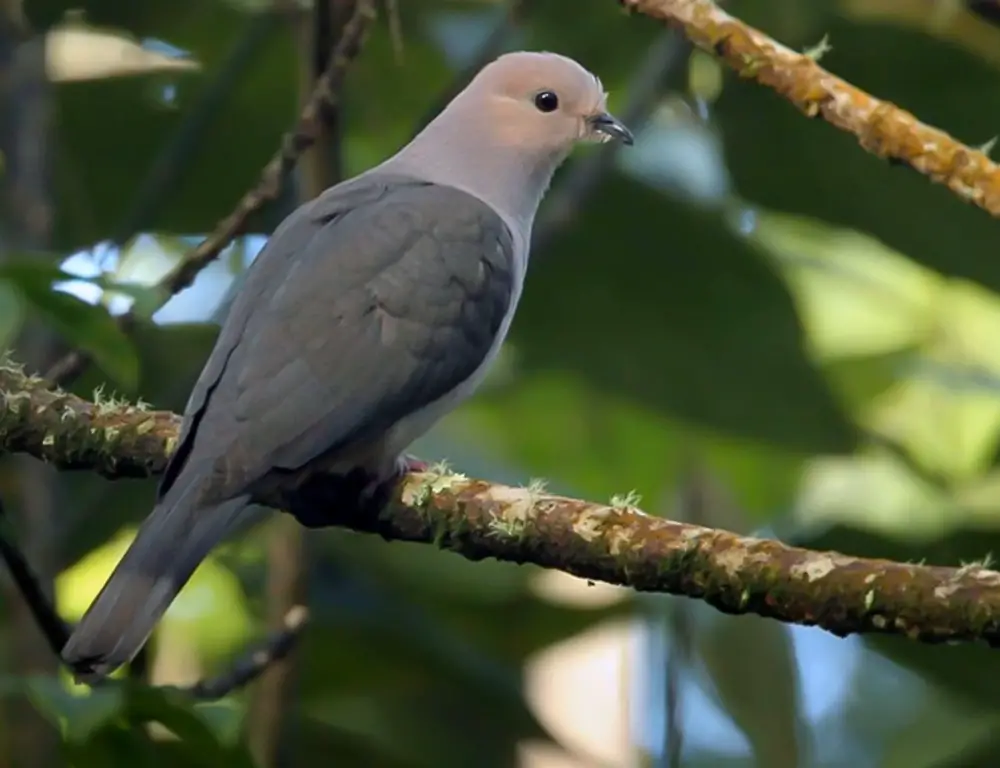With its commanding presence and distinctive traits, the Dark-Backed Imperial Pigeon is a captivating subject for avian enthusiasts. Hailing from Southeast Asia, this pigeon’s dark plumage and imposing size set it apart from its urban counterparts.
However, its allure extends beyond its striking appearance, delving into its intriguing lifestyle and ecological significance. Preferring forested habitats at higher altitudes, these pigeons embody freedom in their natural environment.
Their predominantly frugivorous diet underscores their role in seed dispersal, contributing to the vitality of their ecosystems. This exploration aims to unveil every facet of the Dark-Backed Imperial Pigeon, from habitat preferences to conservation status.
Through increased awareness and understanding, we endeavor to foster appreciation and conservation efforts for this remarkable species among fellow bird enthusiasts and conservationists.

Physical Characteristics of Dark-Backed Imperial Pigeons
The Dark-Backed Imperial Pigeon (Ducula lacernulata) boasts several distinctive physical characteristics that make it a remarkable species. Here’s an overview:
Size
Dark-Backed Imperial Pigeons are notably large birds, measuring around 45 centimeters (18 inches) in length from head to tail. This size places them among the larger species of pigeons.
Plumage
As their name suggests, these pigeons have predominantly dark plumage on their backs, ranging from glossy greenish-black to dark gray.
The upper parts of their bodies exhibit this dark coloring, while their underparts are typically paler in comparison, often a lighter shade of gray or white.
Sexual Dimorphism
There is some degree of sexual dimorphism in Dark-Backed Imperial Pigeons, with males generally displaying darker and richer colors than females. This difference in plumage coloration can help distinguish between male and female individuals.
Bill
One of the most prominent features of Dark-Backed Imperial Pigeons is their large, robust bill, typically colored in shades of red or orange. This robust bill is well-suited for cracking open seeds and nuts and grasping and manipulating food items.
Eyes
These pigeons have striking eyes framed by distinctive maroon-colored orbital skin. This feature adds to their aesthetic appeal and may serve various functions, including visual communication and species recognition.
Wings
Dark-Backed Imperial Pigeons possess broad wings that enable them to soar and glide effortlessly through the air. Their wingspan and powerful flight muscles allow them to cover long distances while foraging or migrating.
Legs and Feet
Their legs are sturdy and well-adapted for perching and walking on various surfaces. Equipped with sharp claws, these pigeons can securely grasp branches and tree trunks, facilitating their arboreal lifestyle.
Habitat and Distribution of Dark-Backed Imperial Pigeons

The Dark-Backed Imperial Pigeon (Ducula lacernulata) inhabits a specific range within Southeast Asia, characterized by lush forests and diverse ecosystems.
Here’s an overview of its habitat and distribution:
Regions
Dark-Backed Imperial Pigeons are primarily found in Southeast Asian countries, including Indonesia, Malaysia, Myanmar, and Thailand. Within these countries, they inhabit various islands and regions with suitable forested habitats.
Habitats
These pigeons prefer dense, evergreen forests, particularly those at higher elevations. They are often found in montane forests, hill forests, and tropical rainforests, where they have access to abundant food sources and suitable nesting sites.
Their habitat preference also includes areas with diverse fruit-bearing trees, which form a significant part of their diet.
Elevation
Dark-Backed Imperial Pigeons are commonly observed in habitats ranging from lowland forests to higher elevations, typically between 300 meters and 1800 meters above sea level.
They are adaptable to a range of elevational gradients, although they tend to favor environments with cooler temperatures at higher altitudes.
Distribution within Countries
Dark-Backed Imperial Pigeons may have localized distributions within their range based on habitat availability, food abundance, and geographical features.
They may be more abundant in certain regions with suitable forested habitats, while their presence may be limited in areas undergoing significant habitat loss or degradation.
Conservation Concerns
Despite their wide distribution across Southeast Asia, Dark-Backed Imperial Pigeons face conservation challenges, primarily due to habitat loss, fragmentation, and degradation.
Deforestation, driven by agricultural expansion, logging, and urbanization, significantly threatens their survival. Conservation efforts are crucial for protecting their habitats and ensuring their long-term viability.
The behavior of Dark-Backed Imperial Pigeons
The behavior of the Dark-Backed Imperial Pigeon (Ducula lacernulata) is fascinating and reflects its adaptation to its forested habitat and frugivorous diet.
Here’s an overview of their behavior:
Diet
Dark-Backed Imperial Pigeons are primarily frugivorous, meaning they mainly feed on fruits. Fruits such as figs are a staple of their diet, but they may also consume other fruits, seeds, and occasionally small insects.
Their diet influences their foraging behavior, as they are often observed searching for ripe fruits in the forest canopy.
Foraging
These pigeons are arboreal, spending much of their time foraging in the upper levels of the forest canopy. They use their strong legs and sharp claws to grip onto branches while they pluck fruits from trees.
Their broad wings enable them to maneuver through the dense vegetation of their forest habitat in search of food.
Social Behavior
Dark-Backed Imperial Pigeons are generally observed in small groups or pairs, particularly during breeding.
They may engage in social interactions such as vocalizations and displays, which play a role in maintaining pair bonds and territorial boundaries within their habitat.
Breeding
Like many bird species, Dark-Backed Imperial Pigeons are monogamous and form long-lasting pair bonds. During the breeding season, male pigeons court females through displays and vocalizations.
Once paired, they build a nest using twigs and other materials, typically situated in the canopy of trees. Female pigeons lay one or two eggs, and both parents share incubation duties and feeding responsibilities for the chicks.
Communication
Dark-Backed Imperial Pigeons communicate through various vocalizations, including cooing sounds and calls. These vocalizations serve multiple purposes, including mate attraction, territorial defense, and maintaining social bonds within groups or pairs.
Flight
Their mighty wings enable Dark-Backed Imperial Pigeons to undertake long flights across their forested habitat.
They may travel significant distances in search of food or suitable nesting sites, utilizing their aerial capabilities to navigate through the dense vegetation of their environment.
Roosting
These pigeons often roost high up in the treetops, seeking shelter and protection from predators. Roosting in elevated positions gives them a vantage point to survey their surroundings and detect potential threats.
Conservation Status of Dark-Backed Imperial Pigeons
The conservation status of the Dark-Backed Imperial Pigeon (Ducula lacernulata) is a matter of concern, as the species faces various threats that have led to population declines.
Here’s an overview of its conservation status:
IUCN Red List Status
The Dark-Backed Imperial Pigeon is classified as “Near Threatened” on the International Union for Conservation of Nature (IUCN) Red List of Threatened Species.
This designation indicates that the species risk becoming endangered if ineffective conservation measures are implemented.
Threats
The primary threats to the Dark-Backed Imperial Pigeon include habitat loss, degradation, and hunting.
Deforestation, driven by agricultural expansion, logging, and urbanization, has destroyed and fragmented the pigeon’s forest habitat.
Loss of suitable habitat reduces available nesting sites and food sources, impacting the species’ ability to survive and reproduce.
Hunting and Trapping
Dark-Backed Imperial Pigeons are also targeted by hunters for their meat and may be trapped for the illegal pet trade. Hunting pressure and weak enforcement of wildlife protection laws exacerbate the threat to the species’ survival.
Population Declines
Population declines have been observed in various parts of the Dark-Backed Imperial Pigeon’s range, particularly in regions where habitat loss and hunting are prevalent.
Reduced population numbers and fragmented populations increase the species’ vulnerability to extinction risks, such as loss of genetic diversity and stochastic events.
Conservation Efforts
Conservation efforts to protect the Dark-Backed Imperial Pigeon and its habitat include establishing protected areas, habitat restoration initiatives, and community-based conservation projects.
These efforts focus on mitigating the threats of habitat loss and hunting through law enforcement, habitat management, and community engagement.
Research and Monitoring
Research efforts to understand the ecology, behavior, and population dynamics of the Dark-Backed Imperial Pigeon are essential for informing conservation strategies and monitoring the species’ status over time.
Population surveys, habitat assessments, and ecological studies contribute valuable conservation planning and decision-making data.
FAQs
Do Dark-Backed Imperial Pigeons migrate?
Dark-Backed Imperial Pigeons may undertake seasonal movements or migrations within their range in response to changes in food availability or environmental conditions. Still, they have yet to be known for long-distance migrations.
What is the lifespan of Dark-Backed Imperial Pigeons?
The lifespan of Dark-Backed Imperial Pigeons in the wild is typically several years, with factors such as predation, disease, and habitat quality influencing their longevity.
Are Dark-Backed Imperial Pigeons social birds?
Dark-Backed Imperial Pigeons are typically observed in pairs or small groups, exhibiting social behaviors such as vocalizations and displays, particularly during the breeding season.
What threats do Dark-Backed Imperial Pigeons face in the wild?
Dark-Backed Imperial Pigeons face threats such as habitat loss due to deforestation, habitat degradation, hunting for meat, and illegal pet trade.
Are Dark-Backed Imperial Pigeons commonly kept as pets?
While Dark-Backed Imperial Pigeons are admired for their beauty, they are not commonly kept as pets due to their wild nature and conservation status. Keeping them as pets may also be illegal in certain regions.
Conclusion
The Dark-Backed Imperial Pigeon is a captivating symbol of nature’s beauty and resilience. Our exploration uncovered its majestic presence in Southeast Asia’s forests, its dietary reliance on fruits like figs, and its unfortunate “Near Threatened” status due to deforestation and hunting.
However, by rallying together, we can champion conservation efforts to safeguard this species.
Preserving the Dark-Backed Imperial Pigeon isn’t just about protecting a single species; it’s about maintaining biodiversity, preserving our natural heritage, and ensuring future generations can marvel at its splendor.
Let us embrace our role as stewards of the Earth, advocating for the conservation of all creatures, including the remarkable Dark-Backed Imperial Pigeon.
